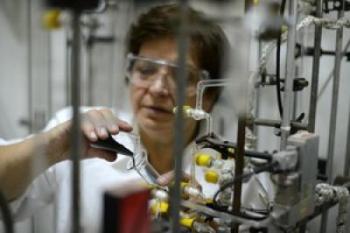Jun 20 2013
Industrial palladium-copper catalysts change their structures before they get to work, already during the activation process. As a result, the reaction is catalysed by a catalyst that is different from the one originally prepared for it. This surprising discovery was made by researchers from the Institute of Physical Chemistry of the Polish Academy of Sciences in Warsaw.
 Dr. Magdalena Bonarowska from the Institute of Physical Chemistry of the Polish Academy of Sciences (IPC PAS) in Warsaw puts a weighted amount of Pd-Cu/SiO2 catalyst into an experimental setup for studying catalytic hydrogen-assisted dechlorination of tetrachloromethane. (Credit: IPC PAS / Grzegorz Krzy¿ewski)
Dr. Magdalena Bonarowska from the Institute of Physical Chemistry of the Polish Academy of Sciences (IPC PAS) in Warsaw puts a weighted amount of Pd-Cu/SiO2 catalyst into an experimental setup for studying catalytic hydrogen-assisted dechlorination of tetrachloromethane. (Credit: IPC PAS / Grzegorz Krzy¿ewski)
Removing of nitrates from ground water or chlorine from dry cleaning wastes are important environmental protection operations that require the use of appropriate catalysts. Popular catalysts include well-known silica-supported palladium-copper catalysts. A team of researchers led by Prof. Zbigniew Karpiñski from the Institute of Physical Chemistry of the Polish Academy of Sciences (IPC PAS) in Warsaw has shown that these catalysts behave differently than assumed to date.
Catalyst is a chemical that speeds up a chemical reaction by participating in it and is regenerated after the reaction is completed. Apart from profiting from shorter reaction time, the use of a catalyst may result in increased reaction selectivity, i.e., a higher yield of the target product as compared with the by-products.
Selective catalysts are usually systems composed of more than one metal. Palladium catalysts are often modified with copper. Active catalyst nanoparticles are deposited on a silica (SiO2) support. Before reaction, so prepared palladium-copper (Pd-Cu) catalyst is heated at high temperature in the presence of hydrogen. The purpose of the operation is to activate the catalyst, which means to provide the catalyst's atoms with energy allowing them for participation in the final reaction.
The ratio of amounts of both metals used in the catalyst has a substantial effect on the operational efficiency of a bimetallic catalyst. "With x-ray measurements we discovered something the researchers were not aware of to date", says Dr Magdalena Bonarowska (IPC PAS). Analytical results indicated that during the activation process in the hydrogen atmosphere at temperatures above 400 °C palladium interacts with silica in the support – and so escapes from active catalyst's nanoparticles. "A catalyst originally composed of, say, 75% palladium and 25% copper can have the ratio of metals strongly disturbed, for instance 50% to 50%. Moreover, its crystal structure changes. This means that the reaction will be catalysed by a catalyst that is different from the one originally prepared!", states Dr Bonarowska.
Palladium losses from the active catalyst's nanoparticles lead to faster catalyst deactivation. Practically, it translates into additional, substantial costs related to unloading of a chemical reactor and regeneration or even replacement of the catalyst inside the reactor.
"It's not uncommon that silica-supported palladium-copper catalysts must be activated at temperatures as high as 500 °C. The operation aims at possibly ideal mixing of both metals dispersed on the surface of the support. It is, however, worth to consider if – provided the target reaction allows for that – the activation of the catalyst at lower temperatures, but for instance for a longer time, wouldn't be a better solution", notices Prof. Karpiñski.
Palladium-copper catalysts on various supports, including silica, are used for removal of nitrates from ground water, and for selective reduction of numerous organic chemicals, including the reduction of nitro compounds to amines, and unsaturated hydrocarbons (e.g., acetylene to ethylene or butadiene to butene). They are also used for electrocatalytic oxidation of methanol and hydrogen-assisted dechlorination, i.e., chlorine removal from harmful organic chemicals with hydrogen.